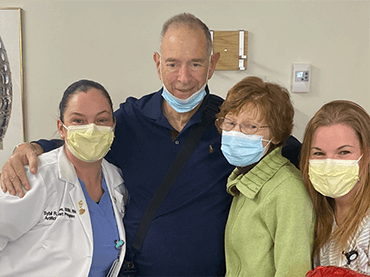In 2017, Bill began experiencing shortness of breath. Over the next three months, his symptoms continued to worsen and make everyday tasks difficult.
“I was retired at that point, and it seemed like when I walked or moved around too much, I would have to stop and catch my breath,” says Bill.
The Ohio resident decided to turn to the experts at UPMC. Bill had previously received treatment at UPMC Presbyterian for other health concerns, and the great experience he had with the team brought him back for his heart care.
“All of the physicians at UPMC Presbyterian are so knowledgeable and skilled,” says Bill. “I have never had a bad or mediocre experience there.”
When Bill and his wife, Sharon, arrived at UPMC Presbyterian, he was thoroughly evaluated by the team at the UPMC Heart and Vascular Institute. They ran tests to analyze his heart function and determine his next steps in care.
“The team evaluated me for heart failure,” says Bill. “I have been so fortunate with the physicians that I have come across. From Dr. Hickey, to more recently, Dr. Keebler, they are extremely competent. They also work so well with the patient in every way.”
Mary Keebler, MD, is the medical director of the Advanced Heart Failure Center at UPMC. Gavin Hickey, MD, is the medical director of the Ventricular Assist Device Program and program director of Advanced Heart Failure and Transplant. Dr. Keebler and Dr. Hickey, along with the entire team at the UPMC Heart and Vascular Institute, provide comprehensive care to treat the full scope of heart conditions.
“The physicians that you see at UPMC work so well together,” says Bill. “They communicate so clearly with the patient and answer any questions you have. The APPs also work well hand in hand to take care of the patients.”
The Solution: Left Ventricular Assist Device (LVAD)
The team at the UPMC Heart and Vascular Institute determined that Bill’s heart was not pumping blood efficiently to the rest of his body. After thoroughly evaluating Bill’s health and testing to determine his candidacy, Dr. Hickey recommended that Bill be placed on a left ventricular assist device (LVAD).
The LVAD is a surgically implanted, battery-operated pump that helps the left ventricle pump blood to the rest of the body. It can serve as a bridge to transplant, providing a life-saving therapy to patients awaiting a new heart. Or, an LVAD can serve as a long-term treatment for patients who may not be candidates for heart transplant. The goal of an LVAD is to extend life and improve quality of life for people suffering from end-stage heart failure.
Bill successfully underwent surgery with the team to receive his LVAD. Following the procedure, Bill spent time recovering at the hospital with the team at UPMC. His wife, Sharon, was a constant source of support.
“Sharon has been with me every day that I’ve been at UPMC,” says Bill. “She comes in first thing in the morning and stays the entire day. When I went home after the LVAD, she took such good care of me and has always been on top of things.”
After recovery, patients with an LVAD will need to care for the device and live a heart-healthy lifestyle. Your care team may recommend cardiac rehabilitation to help you grow stronger and learn healthy habits. Living with the device will require lifestyle adjustments, including avoiding contact sports, smoking and drinking alcohol, and swimming or hot tubs.
“It’s a new norm after the device,” says Bill. “There are things I can do now and some limitations. I can now go grocery shopping with my wife and help her around the house.”
Bill continues to follow up with the team at UPMC Presbyterian for monthly appointments to ensure that the LVAD is functioning properly. In Feb. 2023, the LVAD team helped Bill celebrate his 6-year milestone on the device.
“The team is wonderful to work with,” says Bill. “In order to be successful, the patient has a responsibility to make changes and follow what their care team recommends. Life with this device is like a three-legged stool: one leg is the physician group, the second group is the APPs, the third leg is my wife and me. If every leg is strong, it works well together.”
Bill’s treatment and results may not be representative of similar cases.
















